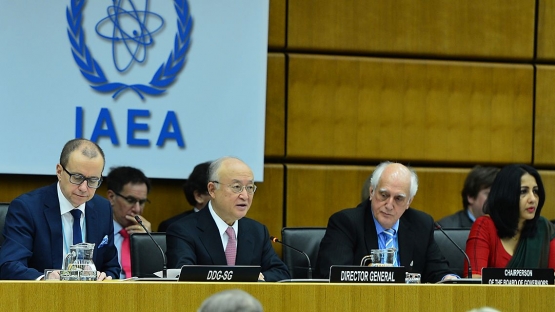The IAEA Board of Governors today considered the Director General’s Final Assessment on Past and Present Outstanding Issues Regarding Iran’s Nuclear Programme and adopted a resolution.
In his opening statement, Mr Amano summarized the main findings of his report:
“The Agency assesses that a range of activities relevant to the development of a nuclear explosive device were conducted in Iran prior to the end of 2003 as a coordinated effort, and some activities took place after 2003.
The Agency also assesses that these activities did not advance beyond feasibility and scientific studies, and the acquisition of certain relevant technical competences and capabilities.
The Agency has no credible indications of activities in Iran relevant to the development of a nuclear explosive device after 2009. Nor has the Agency found any credible indications of the diversion of nuclear material in connection with the possible military dimensions to Iran’s nuclear programme.”
The report was the IAEA’s final step under the Road-map for the clarification of past and present outstanding issues regarding Iran’s nuclear programme, concluded between the IAEA and Iran last July. The Road-map set out a process, under the November 2013 Framework for Cooperation between Iran and the IAEA, to enable the IAEA, with the cooperation of Iran, to make an assessment of issues relating to possible military dimensions to Iran’s nuclear programme by the end of 2015.
“As is the case with all my reports, the assessment is factual, technically sound and balanced,” Mr Amano said. “The methodology and information on which my assessments are based have been set out.”
Next steps
Mr Amano noted that the next step was for Iran to complete the necessary preparatory steps to start implementing the Joint Comprehensive Plan of Action (JCPOA), agreed in July by Iran and six countries and the European Union, known as the E3/EU+3.
The question of how additional activities to be undertaken by the IAEA in Iran under the JCPOA will be funded must also be addressed, Mr Amano noted. He had estimated that the IAEA’s annual expenditure related to the implementation of the JCPOA would total 9.2 million euros.
“Much work lies ahead of us,” Mr Amano concluded. “All parties must fully implement their commitments under the JCPOA. Considerable effort was required in order to reach this agreement. A similar and sustained effort will be required to implement it.”
Call for cooperation
The Board called on Iran “to cooperate fully and in a timely manner with the IAEA,” and implement its comprehensive safeguards agreement and the additional protocol. The additional protocol grants the IAEA expanded access to materials and sites beyond declared nuclear facilities and materials, allowing the IAEA to eventually conclude that it has found no indication of the diversion of declared nuclear material from peaceful nuclear activities and no indication of undeclared nuclear material or activities.
The Board has also agreed that it will – on receipt of an IAEA report verifying that Iran had taken all actions specified in the JCPOA – terminate the relevant resolutions it had previously passed in connection with Iran’s nuclear programme. This will allow Iran to participate in all IAEA technical cooperation activities, for instance.




